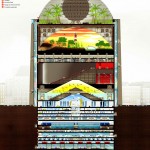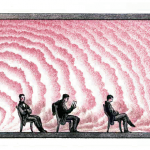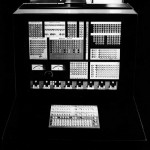An interesting lecture -in Italian- from an almost 35 years old issue of Ottagono, (an Italian architecture and design magazine still living today) about the social history of the relationship between women, work and the domestic environment.
The technological and architectural evolution of the kitchen’s equipments runs parallel with gender struggles and emancipation, capitalist automation, utopian collectivism.
Some images captions, below, are translated by us. Click the pages to zoom.

One of the first patterns for the organization at various levels of the kitchen’s work. Note the drawers to hold the rye and whole wheat flour for making bread.

Diagram of the kitchen designed by Franz Schuster for some housing in Frankfurt, about 1925.

With the ’40s a mechanistic conception of domestic functions emerges, with overly optimistic forecasts for the future. Here the design of George Nelson for a kitchen as a work center (from “Fortune Magazine” 1944)

The kitchen, designed as a motor housing with real limbs that move around it, creates a new phenomenology of living. Proposal by Daniel Chenut, 1965

What is the future of the stove? The pan element becomes independent and autonomous, inevitably emptying the stove-tool of any meaning. Humorous typological interpretation by Daniel Chenut.

Mono-Block diagram produced under the auspices of the Office Central de Chauffe Rationnel et de l’Electricité de France (1958)

In recent years there has been a natural reaction, especially by young people, to the excess of functionalism, and the monotonous perfection of the “Good Design”, the flagship of industrial capitalism and thus a return to spontaneity, to simple manners, to countryside traditions. But even this “recherche” soon became a fad, a “style” so that some periodicals identified an ideology our of this trend, sometimes offering to the readers some paradoxical and impossible aspects.

The Boffi “E15” in a production designed by Corsini and Wiskemann; in its linearity it becomes a wall system.





Leave a Reply